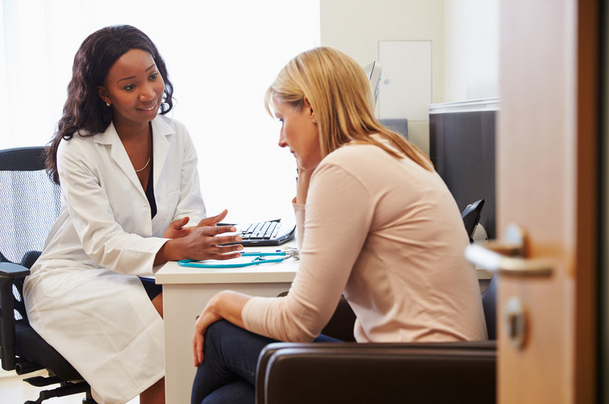I remember the first time I felt what I would later discover was endometriosis. I was fifteen, and I had recurrent stabbing pain in the lower left side of my abdomen. It was the worst pain I had ever felt. I was sweating. My mom took me to my pediatrician, an older man who had been my doctor since I was born.
“It’s just cramps,” he told us. “The only other thing I can think of is if her appendix were on the wrong side, but we would have known that by now.”
There was never any mention of endometriosis. I spent years suffering from horrifically heavy periods, pain that kept me in hot bathtubs and chewing NSAIDs like candy (not advised, but I didn’t know any better), and, occasionally, doubling over suddenly as if I had just been shot or stabbed in the lower abdomen.
It wasn’t until the eighth or ninth ovarian cyst that I learned I had endometriosis. I went to the hospital because the pain was so intense and discovered I had cysts on both ovaries. It was a Friday afternoon. “Don’t worry,” the tech said, “if you are still in pain on Monday, schedule an appointment with your gynecologist.”
On Saturday night, I was at my waitressing job. As the night went on, the pain became so intense I was unable to stand up straight. I was sweating as it rolled over me in waves. I left to go to a different emergency room.
A pelvic exam and an ultrasound revealed that one cyst had burst, but the other had grown significantly in just 24 hours. The doctors were not certain it wasn’t torquing my ovary — cutting off the blood supply.
“We need to do surgery immediately,” the on-call surgeon said. I was terrified. I was 24 years old, and there was a very real danger that I would lose that ovary. I didn’t realize that the other danger was waiting to be discovered.
I woke after my surgery fighting through anesthesia, grabbing for my doctor’s arm: “Did you take my ovary?” Thankfully, he had saved it. As I came out of my anesthesia fog, he told me more.
“We found endometriosis,” he said. “It’s scattered like buckshot over your ovaries and fallopian tubes.” He had pictures from my surgery to show me the black spots that had been growing, unbeknownst to me, like black mold, hiding under my skin.
That doctor became my gynecologist for several years until I moved out of state. I had several more ovarian cysts, though none were removed surgically. I went on hormonal birth control to “quiet the endometriosis,” but I didn’t get a menstrual cycle for four years.
Endometriosis and infertility
And then, when I started trying to get pregnant, I…couldn’t. No doctor or specialist could explain it to me. It was after several years, timed cycles with medication, failed IUIs, a canceled IVF cycle, and an IVF cycle that resulted in zero viable embryos that a doctor finally gave me a diagnosis: Unexplained Infertility.
Sadly, no one told me endometriosis was the likely cause of my infertility. But, knowing what I do now, I wonder if they should have suspected it had something to do with it.
Endometriosis and failed implantation or recurrent miscarriage
In speaking with Dr. Bruce Lessey of Wake Forest University and Dr. Steve L Young of Duke University — IVF doctors who have done extensive research on the causes of IVF failure and recurrent pregnancy loss — it turns out that the most common reason given to almost two-thirds of patients for infertility, recurrent miscarriage, and pregnancy loss, is… Unexplained.
However, in many cases, there is data to suggest that it may be due to inflammation of the uterine wall lining commonly associated with endometriosis, or “silent endometriosis”.
What is "silent" endometriosis?
The main sign of silent endometriosis is failed implantation and/or recurrent pregnancy loss with none of the normal symptoms of endometriosis. Because it affects the uterine wall lining, endometriosis can impact the ability of an embryo to implant and grow in the uterus. The condition can also develop outside the uterus to other organs like the ovaries. Women with symptomatic endometriosis often experience painful periods, excessive bleeding, fatigue, and pain during sex. The absence of symptoms makes silent endometriosis harder to diagnose and is the leading cause of unexplained infertility.
Even without obvious symptoms, your OB/GYN or reproductive endocrinologist can check for signs of endometriosis before they start fertility treatment using a test called ReceptivaDx. The test looks for high levels of BCL-6, a protein marker highly associated with uterine inflammation, most often linked to endometriosis. Without undergoing surgery or testing for BCL-6, a patient may not be aware they have endometriosis.
Even if a patient’s outward symptoms do suggest endometriosis, Doctors Lessey and Young still recommend using BCL-6 to help confirm the diagnosis. Another marker, CD138 can be performed on the same sample and rule out or identify endometritis.
Testing for BCL-6 and what to do after
The good news is: that if the ReceptivaDx test does come back positive for BCL-6 or CD138, there are treatment options. If the CD138 marker is positive for clusters of plasma cells, it indicates chronic endometritis, a bacterial infection that can be treated with a few weeks of antibiotics. If the BCL-6 returns positive, the treatment options are 1) 60 days of hormone suppression before starting an IVF cycle or 2) surgical laparoscopy.
There’s no doubt that the impact of grieving recurrent implantation failure or multiple pregnancy losses takes a tremendous physical and emotional toll. But know that if you’re dealing with an exceptionally long and difficult fertility journey, there is hope. Unexplained infertility can feel like a senseless diagnosis, but ReceptivaDx can help determine, or at least rule out a potential cause. To learn if you may be suffering from silent endometriosis, ask your doctor about ReceptivaDx and inquire about getting tested for BCL-6 and CD138. At the very least, it will bring you one step closer to finding a treatment option that will help you bring home a baby.
Kristin Diversi is a writer and versatile creative. She is passionate about reproductive health and justice and lives in Longmont, Colorado, with her husband and their son.









.webp)

















